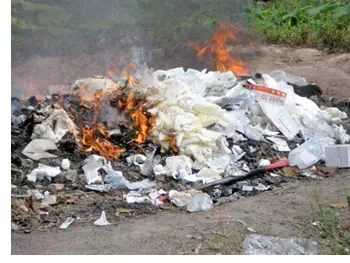
Open Burning
Introduction
Air Pollution Regulations
Solid Waste Issues
Stormwater Issues
More Resources
Introduction
The burning of leaves and brush, other vegetation, backyard trash burning, as well as construction site refuse burning results in smoke. Smoke is caused by incomplete combustion and it contains a number of hazardous air pollutants. Some of the components of smoke can cause cancer as well as other adverse health effects.
Regulations restricting or prohibiting open burning are typically written and enforced by state, regional, and/or local governments. These rules are aimed at reducing the generation of smoke, preventing smoke and ash from impacting people and the environment, and preventing wildfires. Examples of typical regulations are given below:
-
States often have rules covering various aspects of open burning, such as limits on the types of materials that can be burned, quantity, and hours of the day when burning can be performed (e.g., see North Carolina's Open Burning Rule).
-
Open burning is often regulated locally by a fire code or ordinance that has its roots in state law (e.g., City of Huntsville Code of Ordinances, Article III Open Burning).
-
Many localities limit open burning to vegetation removed from the property during clearing. In many areas you are required to obtain a permit for this type of open burning (e.g., see Washington State Department of Ecology Air Quality Program).
-
Other rules require that the vegetation must be dried for a minimum number of days before burning, and limit the diameter of logs that can be burned (e.g., see West Virginia Air Quality Regulation for Open Burning).
-
Some areas completely prohibit open burning of construction debris (e.g., see Montgomery County, MD).
Residential open burning of solid waste (e.g. in 55-gallon drums, etc.) produces ash that can contain toxic metals such as mercury, lead, chromium and arsenic. State and local solid waste rules may limit residential disposal options. Commercial sites (e.g., construction) must abide by federal/state solid waste disposal regulations, including hazardous waste regulations, if applicable. For more information on state regulations, see Hazardous Waste Resource Locator and Solid Waste Resource Locator.
Open burning pits at construction sites need to be addressed by the stormwater pollution prevention plans (SWPPP). See Construction Industry Compliance Assistance (CICA) Center and the Stormwater Resource Locator for state specific information.
BurnBarrels.org. Information concerning the impacts of backyard refuse burning.
Construction & Demolition Debris Resource Locator. C&D wastes are a major source of solid waste. Locate regulatory information and other compliance assistance, lists of C&D landfills, and pollution prevention resources for your state.
